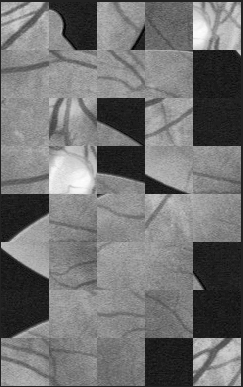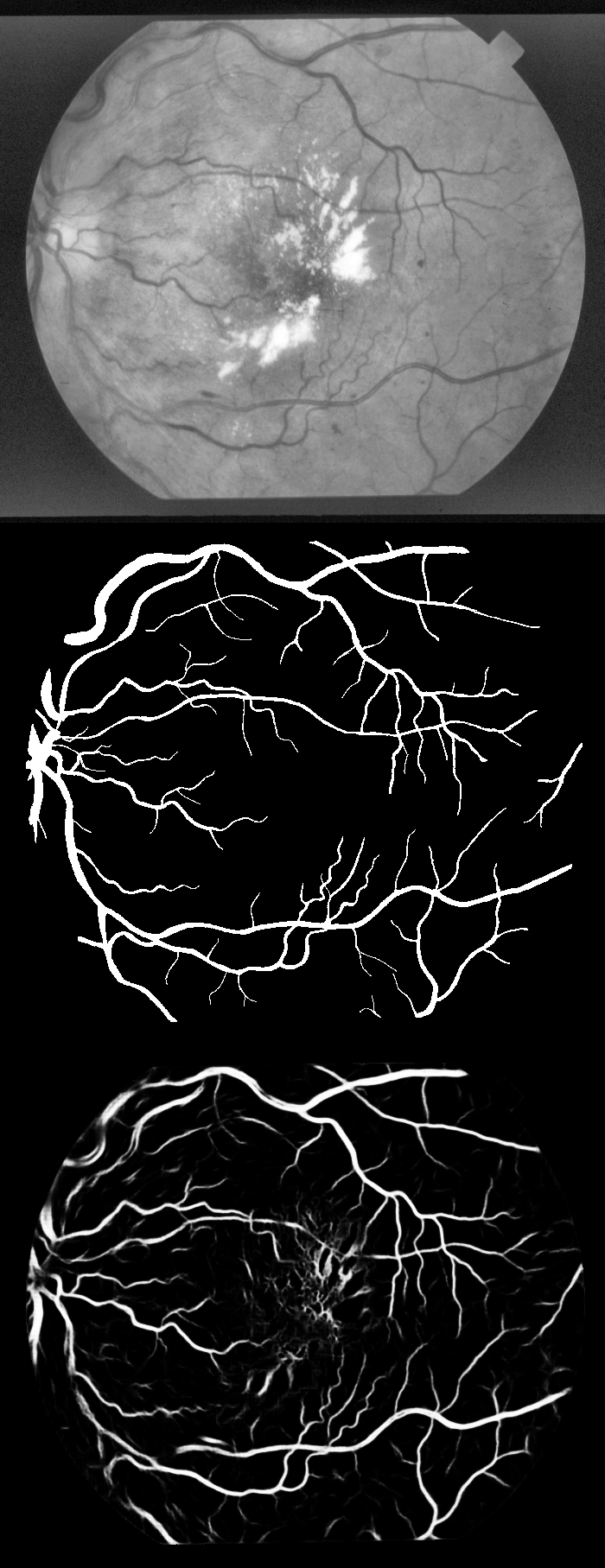github地址:https://github.com/orobix/retina-unet
主程序:
################################################### # # Script to: # - Load the images and extract the patches # - Define the neural network # - define the training # ################################################## import numpy as np import configparser as ConfigParser from keras.models import Model from keras.layers import Input, concatenate, Conv2D, MaxPooling2D, UpSampling2D, Reshape, core, Dropout from keras.optimizers import Adam from keras.callbacks import ModelCheckpoint, LearningRateScheduler from keras import backend as K from keras.utils.vis_utils import plot_model as plot from keras.optimizers import SGD import sys sys.path.insert(0, './lib/') from help_functions import * #function to obtain data for training/testing (validation) from extract_patches import get_data_training #Define the neural network def get_unet(n_ch,patch_height,patch_width): inputs = Input(shape=(n_ch,patch_height,patch_width)) conv1 = Conv2D(32, (3, 3), activation='relu', padding='same',data_format='channels_first')(inputs) conv1 = Dropout(0.2)(conv1) conv1 = Conv2D(32, (3, 3), activation='relu', padding='same',data_format='channels_first')(conv1) pool1 = MaxPooling2D((2, 2))(conv1) # conv2 = Conv2D(64, (3, 3), activation='relu', padding='same',data_format='channels_first')(pool1) conv2 = Dropout(0.2)(conv2) conv2 = Conv2D(64, (3, 3), activation='relu', padding='same',data_format='channels_first')(conv2) pool2 = MaxPooling2D((2, 2))(conv2) # conv3 = Conv2D(128, (3, 3), activation='relu', padding='same',data_format='channels_first')(pool2) conv3 = Dropout(0.2)(conv3) conv3 = Conv2D(128, (3, 3), activation='relu', padding='same',data_format='channels_first')(conv3) up1 = UpSampling2D(size=(2, 2))(conv3) up1 = concatenate([conv2,up1],axis=1) conv4 = Conv2D(64, (3, 3), activation='relu', padding='same',data_format='channels_first')(up1) conv4 = Dropout(0.2)(conv4) conv4 = Conv2D(64, (3, 3), activation='relu', padding='same',data_format='channels_first')(conv4) # up2 = UpSampling2D(size=(2, 2))(conv4) up2 = concatenate([conv1,up2], axis=1) conv5 = Conv2D(32, (3, 3), activation='relu', padding='same',data_format='channels_first')(up2) conv5 = Dropout(0.2)(conv5) conv5 = Conv2D(32, (3, 3), activation='relu', padding='same',data_format='channels_first')(conv5) # conv6 = Conv2D(2, (1, 1), activation='relu',padding='same',data_format='channels_first')(conv5) conv6 = core.Reshape((2,patch_height*patch_width))(conv6) conv6 = core.Permute((2,1))(conv6) ############ conv7 = core.Activation('softmax')(conv6) model = Model(inputs=inputs, outputs=conv7) # sgd = SGD(lr=0.01, decay=1e-6, momentum=0.3, nesterov=False) model.compile(optimizer='sgd', loss='categorical_crossentropy',metrics=['accuracy']) return model #Define the neural network gnet #you need change function call "get_unet" to "get_gnet" in line 166 before use this network def get_gnet(n_ch,patch_height,patch_width): inputs = Input((n_ch, patch_height, patch_width)) conv1 = Convolution2D(32, 3, 3, activation='relu', border_mode='same')(inputs) conv1 = Dropout(0.2)(conv1) conv1 = Convolution2D(32, 3, 3, activation='relu', border_mode='same')(conv1) up1 = UpSampling2D(size=(2, 2))(conv1) # conv2 = Convolution2D(16, 3, 3, activation='relu', border_mode='same')(up1) conv2 = Dropout(0.2)(conv2) conv2 = Convolution2D(16, 3, 3, activation='relu', border_mode='same')(conv2) pool1 = MaxPooling2D(pool_size=(2, 2))(conv2) # conv3 = Convolution2D(32, 3, 3, activation='relu', border_mode='same')(pool1) conv3 = Dropout(0.2)(conv3) conv3 = Convolution2D(32, 3, 3, activation='relu', border_mode='same')(conv3) pool2 = MaxPooling2D(pool_size=(2, 2))(conv3) # conv4 = Convolution2D(64, 3, 3, activation='relu', border_mode='same')(pool2) conv4 = Dropout(0.2)(conv4) conv4 = Convolution2D(64, 3, 3, activation='relu', border_mode='same')(conv4) pool3 = MaxPooling2D(pool_size=(2, 2))(conv4) # conv5 = Convolution2D(128, 3, 3, activation='relu', border_mode='same')(pool3) conv5 = Dropout(0.2)(conv5) conv5 = Convolution2D(128, 3, 3, activation='relu', border_mode='same')(conv5) # up2 = merge([UpSampling2D(size=(2, 2))(conv5), conv4], mode='concat', concat_axis=1) conv6 = Convolution2D(64, 3, 3, activation='relu', border_mode='same')(up2) conv6 = Dropout(0.2)(conv6) conv6 = Convolution2D(64, 3, 3, activation='relu', border_mode='same')(conv6) # up3 = merge([UpSampling2D(size=(2, 2))(conv6), conv3], mode='concat', concat_axis=1) conv7 = Convolution2D(32, 3, 3, activation='relu', border_mode='same')(up3) conv7 = Dropout(0.2)(conv7) conv7 = Convolution2D(32, 3, 3, activation='relu', border_mode='same')(conv7) # up4 = merge([UpSampling2D(size=(2, 2))(conv7), conv2], mode='concat', concat_axis=1) conv8 = Convolution2D(16, 3, 3, activation='relu', border_mode='same')(up4) conv8 = Dropout(0.2)(conv8) conv8 = Convolution2D(16, 3, 3, activation='relu', border_mode='same')(conv8) # pool4 = MaxPooling2D(pool_size=(2, 2))(conv8) conv9 = Convolution2D(32, 3, 3, activation='relu', border_mode='same')(pool4) conv9 = Dropout(0.2)(conv9) conv9 = Convolution2D(32, 3, 3, activation='relu', border_mode='same')(conv9) # conv10 = Convolution2D(2, 1, 1, activation='relu', border_mode='same')(conv9) conv10 = core.Reshape((2,patch_height*patch_width))(conv10) conv10 = core.Permute((2,1))(conv10) ############ conv10 = core.Activation('softmax')(conv10) model = Model(input=inputs, output=conv10) # sgd = SGD(lr=0.01, decay=1e-6, momentum=0.3, nesterov=False) model.compile(optimizer='sgd', loss='categorical_crossentropy',metrics=['accuracy']) return model #========= Load settings from Config file config = ConfigParser.RawConfigParser() config.read('configuration.txt') #patch to the datasets path_data = config.get('data paths', 'path_local') #Experiment name name_experiment = config.get('experiment name', 'name') #training settings N_epochs = int(config.get('training settings', 'N_epochs')) batch_size = int(config.get('training settings', 'batch_size')) #============ Load the data and divided in patches patches_imgs_train, patches_masks_train = get_data_training( DRIVE_train_imgs_original = path_data + config.get('data paths', 'train_imgs_original'), DRIVE_train_groudTruth = path_data + config.get('data paths', 'train_groundTruth'), #masks patch_height = int(config.get('data attributes', 'patch_height')), patch_width = int(config.get('data attributes', 'patch_width')), N_subimgs = int(config.get('training settings', 'N_subimgs')), inside_FOV = config.getboolean('training settings', 'inside_FOV') #select the patches only inside the FOV (default == True) ) #========= Save a sample of what you're feeding to the neural network ========== N_sample = min(patches_imgs_train.shape[0],40)#这里规定,要显示的图片最多不超过40张 visualize(group_images(patches_imgs_train[0:N_sample,:,:,:],5),'./'+name_experiment+'/'+"sample_input_imgs")#.show() visualize(group_images(patches_masks_train[0:N_sample,:,:,:],5),'./'+name_experiment+'/'+"sample_input_masks")#.show() #显示的结果会在下面贴出来 #=========== Construct and save the model arcitecture ===== n_ch = patches_imgs_train.shape[1]#得到每个patch的通道数 patch_height = patches_imgs_train.shape[2]#得到每个patch的高 patch_width = patches_imgs_train.shape[3]#得到每个patch的宽 model = get_unet(n_ch, patch_height, patch_width) #the U-net model print ("Check: final output of the network:") print (model.output_shape) plot(model, to_file='./'+name_experiment+'/'+name_experiment + '_model.png') #check how the model looks like json_string = model.to_json()#model.to_json:返回代表模型的JSON字符串,仅包含网络结构,不包含权值。可以从JSON字符串中重构原模型: open('./'+name_experiment+'/'+name_experiment +'_architecture.json', 'w').write(json_string) #============ Training ================================== checkpointer = ModelCheckpoint(filepath='./'+name_experiment+'/'+name_experiment +'_best_weights.h5', verbose=1, monitor='val_loss', mode='auto', save_best_only=True) #save at each epoch if the validation decreased # def step_decay(epoch): # lrate = 0.01 #the initial learning rate (by default in keras) # if epoch==100: # return 0.005 # else: # return lrate # # lrate_drop = LearningRateScheduler(step_decay) patches_masks_train = masks_Unet(patches_masks_train) #reduce memory consumption model.fit(patches_imgs_train, patches_masks_train, nb_epoch=N_epochs, batch_size=batch_size, verbose=2, shuffle=True, validation_split=0.1, callbacks=[checkpointer]) #========== Save and test the last model =================== model.save_weights('./'+name_experiment+'/'+name_experiment +'_last_weights.h5', overwrite=True) #test the model # score = model.evaluate(patches_imgs_test, masks_Unet(patches_masks_test), verbose=0) # print('Test score:', score[0]) # print('Test accuracy:', score[1])

实验结果显示:上中下分别为原图-groundTruth-预测图
